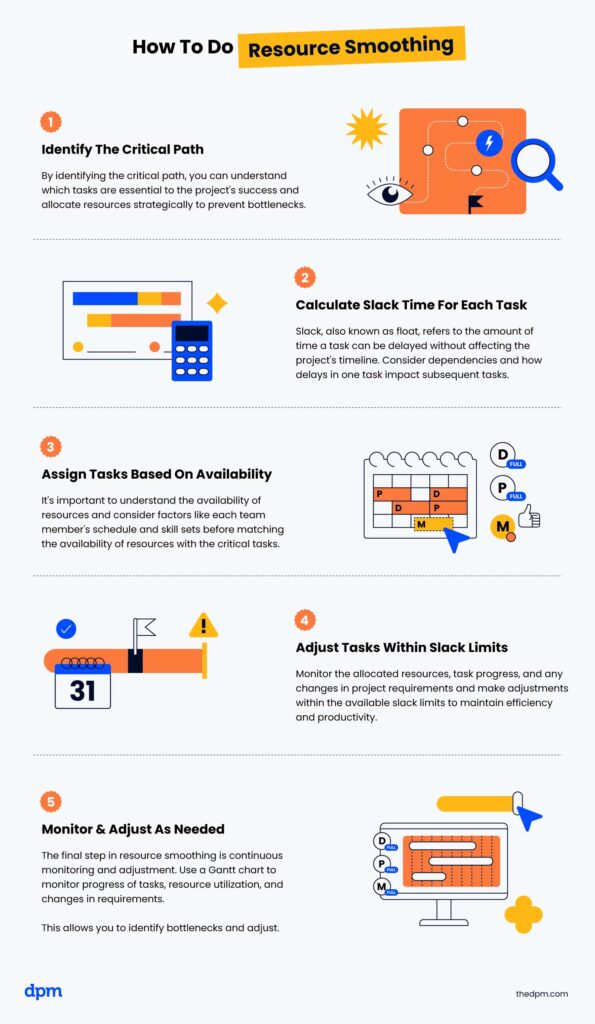Resource smoothing is an essential project and resource management technique that helps organizations balance the demand for project resources with the available capacity to minimize bottlenecks and ensure a steady workflow. Resource management software is typically used in this process.
This simple how-to guide will help you discover its benefits and when and how to use it in your projects.
What Is Resource Smoothing?
Resource smoothing is a project management technique that aims to balance resource demand and capacity without affecting the project’s critical path (and therefore, the project duration).
As a project manager, your goal is to distribute your project workload evenly across resources, ensuring that individual team members or departments are not overwhelmed while others remain underutilized.
Smoothing involves analyzing the resource requirements of each activity in a project and then adjusting resource allocation to ensure more balanced resource usage. In my experience, resource smoothing is critical for projects with limited resources or when resource availability fluctuates.
Resource Leveling vs Resource Smoothing
Here’s how resource leveling and resource smoothing are different.
Resource leveling: This focuses on adjusting the project schedule, using start and finish dates, to resolve resource conflicts. Eliminate overallocation or conflicts by making resource demand more consistent over time. This is done by shifting activities to ensure that resources are not assigned to multiple tasks simultaneously and to avoid conflicts and bottlenecks.
Resource smoothing: Smoothing is used when a time constraint (i.e. a hard deadline) takes precedence over a resource constraint. The critical path is unchanged—resource smoothing considers the available resources and their capacity, and uses free and total float (more on this later) accordingly to get work done by the deadline.
Benefits Of Resource Smoothing
Using resource smoothing in your project management approach offers several benefits:
- Optimized resource utilization: Resource smoothing ensures that resources are utilized efficiently throughout the project by distributing workloads evenly. This minimizes the risk of some team members being overwhelmed while others remain idle.
- Improved project efficiency: With resource smoothing, you can prevent bottlenecks and resource conflicts that can delay project timelines by balancing resource demand and capacity. You can maintain a steady flow of work, improving project efficiency and reducing the need for rework.
- Enhanced team morale: Resource smoothing contributes to a more balanced and manageable workload for team members. When everyone has a more predictable and sustainable workload, it reduces stress and burnout, leading to higher team morale and productivity.
- Better resource planning: One KPMG project management study found that about 22% of projects fail due to inadequate resource forecasting. Analyzing resource requirements and using resource smoothing can provide valuable insights into resource availability and capacity for better resource planning in future projects. This helps organizations make more informed decisions.
- Improves scope management: By preventing bottlenecks and creating a more balanced and manageable workload for team members, resource smoothing ensures that resources are utilized more efficiently throughout your projects. This increases the chances of meeting the scope of the project—and isn't that your goal?
Drawbacks Of Resource Smoothing
While resource smoothing offers numerous benefits, it's important to be aware of these potential drawbacks.
- Additional administrative effort: Implementing resource smoothing requires careful analysis and adjustment of resource allocation. This adds more complexity and additional administrative effort, especially in larger, sophisticated projects.
- Reduced flexibility: Resource smoothing limits your flexibility in moving tasks and adjusting the project schedule, as adjustments need to be made to accommodate time constraints. This can make it challenging to respond to unexpected changes or urgent priorities.
- Potential resource conflicts: Resource smoothing aims to prevent resource conflicts, but it's still possible for conflicts to occur, especially in projects with limited resources. It's necessary to monitor resource utilization closely and address any conflicts immediately.
Although there can be potential drawbacks, resource smoothing is still a valuable technique in resource management, especially in resource-constrained and time-constrained environments. With careful planning and implementation, its benefits far outweigh the challenges.
When To Use Resource Smoothing
Let's explore a few situations in which resource smoothing is best used, to ensure your resource management is impeccable:
- Managing resource conflicts in a software development project: In software development projects, one common scenario where resource smoothing can be applied is when multiple software modules need to be developed simultaneously—causing resource conflicts. By implementing resource smoothing techniques, you can identify the critical path and allocate resources accordingly, ensuring a balanced workload and timely project delivery for each module.
- Handling resource shortages in a construction project: One challenge in construction projects is the lack of skilled labor. Certain trades, such as electricians or plumbers, might be in high demand, resulting in resource shortages. Resource smoothing allows you to identify critical project tasks that require specialized labor and allocate additional resources accordingly to ensure the project progresses smoothly.
- Optimizing resource utilization in a marketing campaign: Resource smoothing in a marketing campaign involves resource allocation that assigns people to various tasks, such as content creation, graphic design, and social media management. By employing resource optimization techniques, you can identify critical tasks and allocate resources based on skill availability and workload distribution.
- Removing bottlenecks in a complex business transformation project: One example of resource smoothing in a business transformation project is optimizing the decision-making process. In these projects, decision-making often involves multiple layers, resulting in delays and inefficiencies. By applying resource smoothing techniques, you can streamline the decision-making process by identifying critical decision points and allocating resources accordingly.
How To Do Resource Smoothing

Implementing resource smoothing in your project management approach involves a step-by-step process that should start with project planning. Let's explore each of these steps in detail:
1. Identify The Critical Path
Resource smoothing begins with identifying a project's critical path. The critical path refers to the series of tasks that must be completed in a specific order and within a certain timeframe to ensure the project's successful completion.
By identifying the critical path, you can use smoothing to understand which tasks are essential to the project's success and allocate resources strategically to prevent bottlenecks and maximize efficiency throughout the project's lifecycle.
2. Calculate Slack Time For Each Task
In addition to identifying the critical path, you need to calculate the slack for each task. Slack, also known as float, refers to the amount of time a task can be delayed without affecting the project's timeline.
As a project manager, you should consider the dependencies between tasks and the resources required for each task. By understanding the relationships between tasks, you can determine how delays in one task may impact subsequent tasks.
3. Assign Tasks Based On Resource Availability
Once the critical path and slack have been identified, you can begin assigning tasks based on resource availability. Resource smoothing involves strategically allocating resources to ensure that the right people are working on the right tasks at the right time.
When assigning tasks, it's important to understand the availability of resources and consider factors like each team member's schedule and skill sets before matching the availability of resources with the critical tasks.
4. Adjust Tasks Within Slack Limits
As your project progresses, you need to monitor the allocated resources, task progress, and any changes in project requirements and make adjustments within the available slack limits to maintain efficiency and productivity.
A well-balanced approach to adjusting tasks within slack limits ensures that efficiency helps maximize resources without compromising the project's success.
5. Monitor & Adjust As Needed
The final step in resource smoothing is continuous monitoring and adjustment—it's an iterative process. You should use a Gantt chart to closely monitor the progress of tasks, resource utilization, and any changes in project requirements. This allows you to identify any potential bottlenecks or inefficiencies and make adjustments as needed.
Regular communication with stakeholders is crucial during this stage. By keeping an open line of communication, you can stay informed about any challenges or resource constraints that may arise. This enables you to address issues promptly and make necessary adjustments to maintain efficiency and productivity.
Join For More Resource Management Insights
Want to connect with other digital project managers and share resources and best practices? Join our membership community and get access to 100+ templates, samples, and examples, and connect with 100s of other digital project managers in Slack.


